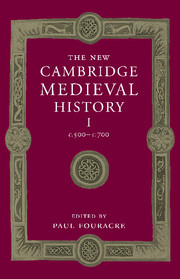Book contents
- Frontmatter
- Introduction: the history of Europe 500–700
- 1 The later Roman Empire
- 2 The Barbarian invasions
- 3 The sources and their interpretation
- PART I THE SIXTH CENTURY
- PART II THE SEVENTH CENTURY
- PART III THEMES AND PROBLEMS
- 20 The Jews in Europe 500–1050
- 21 Kings and kingship
- 22 The Mediterranean economy
- 23 The Northern Seas (fifth to eighth centuries)
- 24 Money and coinage
- 25 Church structure and organisation
- 26 Christianisation and the dissemination of Christian teaching
- 27 Education and learning
- 28A Art and architecture of western Europe
- 28B Art and architecture: the East
- List of Primary sources
- Bibliography of secondary works arranged by chapter
- Index
- Frontispiece"
- Plate section"
- Map 3 Gaul/Francia in the sixth and seventh centuries"
- References
28B - Art and architecture: the East
from PART III - THEMES AND PROBLEMS
Published online by Cambridge University Press: 28 March 2008
- Frontmatter
- Introduction: the history of Europe 500–700
- 1 The later Roman Empire
- 2 The Barbarian invasions
- 3 The sources and their interpretation
- PART I THE SIXTH CENTURY
- PART II THE SEVENTH CENTURY
- PART III THEMES AND PROBLEMS
- 20 The Jews in Europe 500–1050
- 21 Kings and kingship
- 22 The Mediterranean economy
- 23 The Northern Seas (fifth to eighth centuries)
- 24 Money and coinage
- 25 Church structure and organisation
- 26 Christianisation and the dissemination of Christian teaching
- 27 Education and learning
- 28A Art and architecture of western Europe
- 28B Art and architecture: the East
- List of Primary sources
- Bibliography of secondary works arranged by chapter
- Index
- Frontispiece"
- Plate section"
- Map 3 Gaul/Francia in the sixth and seventh centuries"
- References
Summary
The two centuries covered by this volume saw profound changes in material culture, though these changes were configured somewhat differently in the western and eastern halves of the old Roman empire. In both, however, the late antique city and its hegemonic culture increasingly gave way before new urban ideals and new social constructions that affected all aspects of the material world. Established media were given new uses: mosaics, for example, spread from floors to walls and ceilings, and in these cases came to be made predominantly of glass cubes, which allowed a greater range of colours than had the stone cubes suitable for flooring. Relatively new media, such as texts in the form of codices rather than scrolls – a format that became dominant only c.400 – expanded in importance and became a significant marker of church status. Other changes were more geographically constrained. In the eastern half of the Empire, for example, the dome, once restricted to centrally planned structures, joined longitudinal plans by the sixth century. Architectural sculpture continued across the old Empire, but monumental free-standing sculpture was rarely produced; and the bronze doors of Hagia Sophia in Constantinople demonstrate that while the technical skills required to cast large-scale bronze forms persisted in the East, they temporarily atrophied in the West. Meanwhile other techniques, and the motifs that they conveyed, moved in: what used to be called the ‘arts of the migrations’ – primarily metalwork and primarily non-figural – became entrenched in the areas west of the Balkans.
Keywords
- Type
- Chapter
- Information
- The New Cambridge Medieval History , pp. 776 - 784Publisher: Cambridge University PressPrint publication year: 2005



